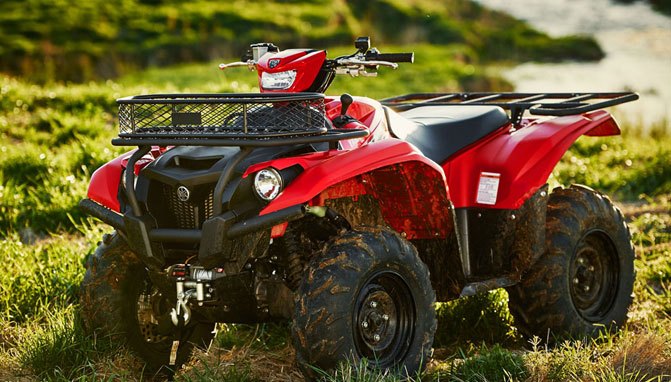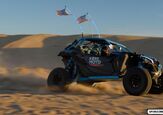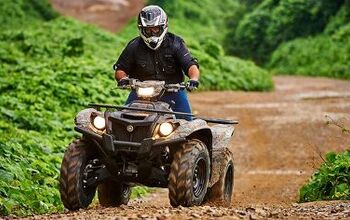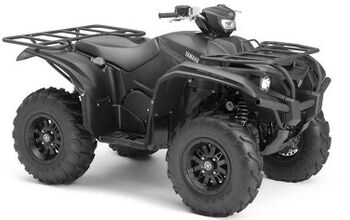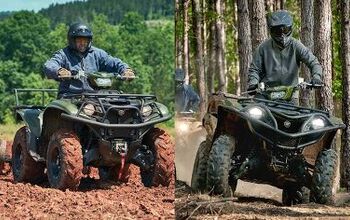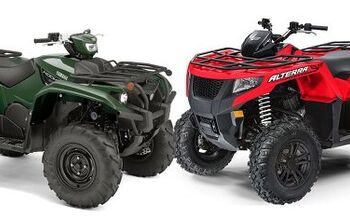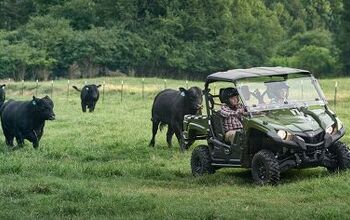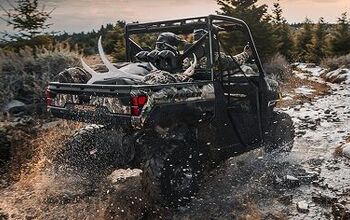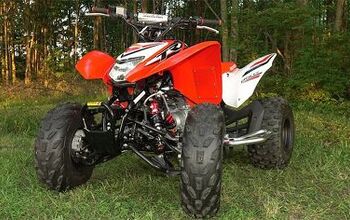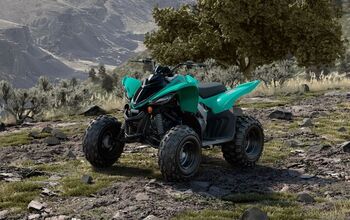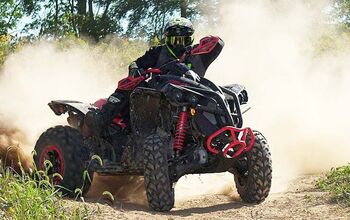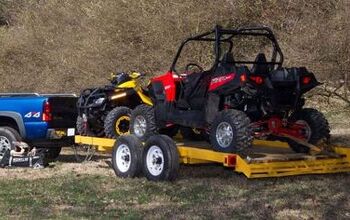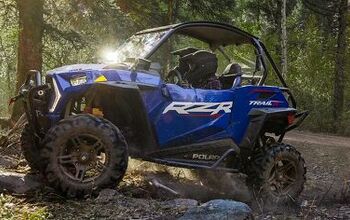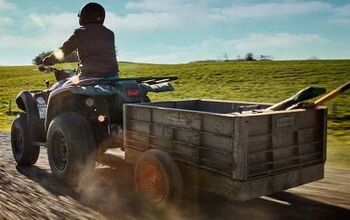2016 Yamaha Kodiak 700 Preview
Yamaha took the most unique approach to middleweight ATVs we’ve ever seen for the 2016 model year. The 450 and 550 class machines have been replaced with the new models featuring the largest engine in Yamaha’s four-wheel lineup. Oh, and they’re cheaper, too. Let’s meet the 2016 Yamaha Kodiak 700 family.
Visit the KodiakOwners.com forum
This is a bit of a confusing tale, but we’ll try to clear it all up for you. It started last year when Yamaha’s 2015 Grizzly lineup only featured 700-class models. The Grizzly 550, 450, 400, and 300 models were all left out in 2015. We assumed that was because dealer inventory was high and they’d return for 2016. We were incorrect.
The Grizzly 550 and 450 models, in particular, were in a bit of a tough spot, the Polaris Sportsman 570 and Can-Am Outlander L 450 and 500 were much less expensive than the fully featured middleweight Grizzlies. Rather than return fire with cheaper machines with similar engines, Yamaha decided to eliminate its middleweight powerplants altogether. In their place, Yamaha built a new chassis to house the new 708cc engine from the new Wolverine UTV (and now the 2016 Grizzly).
Read our review of the 2014 Yamaha Grizzly 700 FI 4×4 EPS
Both the 2016 Grizzly and 2016 Kodiak feature the same basic engine. However, the differences between the two models may outweigh the similarities. That starts with the price. The base 2016 Grizzly 700 retails for $8,899, while the new Kodiak 700 starts at $6,999 – a difference of nearly $2,000. In fact, the new Kodiak has the same MSRP as the 2015 Can-Am Outlander L 500 and is $1,000 less than the 2015 Grizzly 550.
The Kodiak (right) has a more compact profile than the Grizzly (left).
Differentiating the Grizzly and Kodiak will be a big priority for Yamaha and the theory is that the Grizzly is geared towards the enthusiast rider who wants the most off-road capable ATVs available, while the Kodiak is primarily a work and hunting machine aimed at consumers who want affordability and reliability over anything else.
Kodiak 700 Features
While the Kodiak 700 has the same peak horsepower (48.3) and torque as the Grizzly, it doesn’t come on as aggressively. This is very much by design, as Yamaha figures many employers will buy the Kodiak for their employees to use on the job. These employees are likely to be inexperienced riders and hard-hitting power could be a safety concern. As well, the Kodiak revs slower, resulting in less engine noise, which is ideal for hunters.
Though it has the same peak horsepower and torque as the Grizzly, the Kodiak’s power comes on less aggressively and the engine revs slower.
To keep maintenance (and downtime) at a minimum, Yamaha outfitted the Kodiak with a new sealed rear wet brake. It lacks the same aggressive bite as the four-wheel discs on the Grizzly, but the design is basically maintenance free and Yamaha says it suffers no brake fade in water or mud.
Read our review of the 2015 Can-Am Outlander L 500 DPS
Suspension is fully independent front and rear, but the shocks have no adjustability on the base Kodiak.
Compared to the Grizzly, the Kodiak is a more compact machine with a narrower stance. Tires are smaller (25-inch diameter), the handlebar is lower and swoops back farther toward the rider, and the seat is lower. Yamaha says the Kodiak has a compact rider position for relaxed riding and promotes lower sit-in style seating for easy on-off.
As the graphic illustrates, the Kodiak handlebars are lower and swoop back farther toward the rider, compared to the Grizzly.
Rather than a push-button 4WD/differential lock switch, the base Kodiak has a lever-activated 4WD function with mechanical cable and lacks differential lock altogether.
Other features on the base Kodiak include steel racks that can haul 110 pounds up front and 198 pounds in the rear, easy access top (tank) storage with nine pounds of capacity, high-mounted air intake and CVT exhaust, full length three-piece skid plates, and warning indicator lights (rather than digital dash).
Read our review of the 2014 Polaris Sportsman 570 EPS
For price comparison, the base Kodiak 700 ($6,999) is the same price as the Can-Am Outlander L 500, $400 more than the Polaris Sportsman 570, and $800 more than the Honda Rancher 420.
Kodiak EPS
The middle child of the Kodiak family is the Kodiak EPS ($8,199). As the name suggests, this model boasts electronic power steering, handlebar light with high beams, new digital meter, KYB suspension with five-way pre-load adjustable shocks, and two-inch receiver hitch.
For an extra $1,200, the Kodiak EPS features electronic power steering, handlebar light, new digital meter, and upgraded shocks.
For price comparison, the Kodiak 700 EPS is $300 more than the Outlander L 500 DPS, $150 more than the Honda Foreman 500 ES EPS, and $700 more than the Sportsman 570 EPS.
Kodiak SE
At the top of the Kodiak family is the Kodiak SE ($8,899). It has all the same features as the EPS model, along with carbon metallic painted body, push button 2WD/4WD and differential lock, all-wheel engine braking, all-wheel reverse traction, and cast aluminum wheels.
The Kodiak SE features a Grizzly-like 2WD/4WD differential lock, all-wheel engine braking, and cast-aluminum wheels. It also costs the same as the base Grizzly.
For price comparison, the Kodiak 700 SE is $250 less than the Honda Rubicon 500 EPS and $300 more than the Sportsman 570 SP.
What makes the Kodiak SE is particularly interesting is that it comes in at the same price as the base Grizzly, but benefits from power steering, painted body, and cast aluminum wheels. It will lack a bit of the Grizzly performance, but the extra features make it a very nice value.
| 2016 Yamaha Kodiak Specs | 2016 Yamaha Grizzly Specs | |
| Engine: | 708cc liquid-cooled DOHC 4-stroke; 4 valves | 708cc liquid-cooled DOHC 4-stroke; 4 valves |
| Fuel System: | Yamaha Fuel Injection | Yamaha Fuel Injection |
| Transmission: | Yamaha Ultramatic V-belt with all-wheel engine braking; H, L, N, R, P | Yamaha Ultramatic V-belt with all-wheel engine braking; H, L, N, R, P |
| Final Drive: | Lever operated 2WD/4WD; shaft | On-Command 3-way locking differential; 2WD, 4WD, locked 4WD; shaft |
| Front Suspension: | Independent double wishbone; 7.1-in travel | Independent double wishbone; 5-way preload adjustment, 7.6-in travel |
| Rear Suspension: | Independent double wishbone; 9.1-in travel | Independent double wishbone with anti-sway bar; 5-way preload adjustment, 9.1-in travel |
| Brakes: | Front: Dual hydraulic disc | Front: Dual hydraulic disc |
| Front Tires: | AT25 x 8-12 Maxxis MU19 | AT26 x 8-12 Maxxis MU05Y |
| Rear Tires: | AT25 x 10-12 Maxxis MU20 | AT26 x 10-12 Maxxis MU06Y |
| Wheelbase: | 49.2 in | 49.2 in |
| Wet Weight: | 661 lb | 679 lb |
| Length/Width/Height: | 81.5 in x 46.5 in x 48.8 in | 81.5 in x 48.4 in x 49.3 in |
| Ground Clearance: | 10.8 in | 11.3 in |
| Seat Height: | 33.9 in | 36.1 in |
| Fuel Capacity: | 4.76 gal | 4.76 gal |
| Front/Rear Cargo Rack Capacity: | 110/198 lb | 110/198 lb |
| Lighting: | Dual LED headlights, 35/36.5W auxiliary light and LED brake light | Dual LED headlights, 35/36.5W auxiliary light and LED brake light |
I have been working exclusively in digital media since 1997. I started out with TSN.ca, spending nearly nine years creating and editing content on Canada's leading sports website. I left to join VerticalScope, Inc., one of the world's largest online publishers, to start a number of powersports publications. While at VerticalScope, I've helped create and oversee content for a wide variety of different publications, including ATV.com, Off-Road.com, ArcheryTalk.com, Tractor.com, RVGuide.com, and many more.
More by Lucas Cooney



